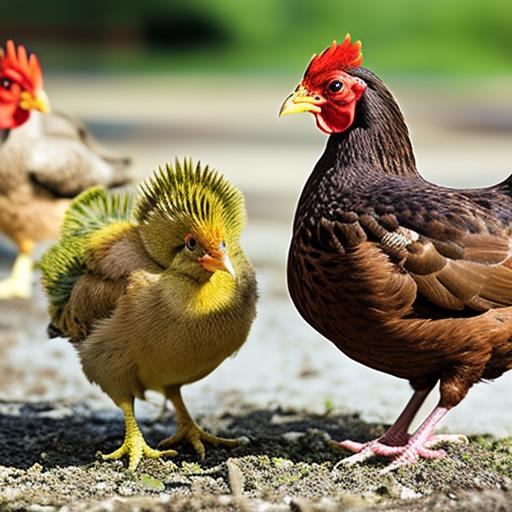Keeping chickens on concrete is a topic that has gained attention in recent years. Many people are interested in raising chickens for various reasons, such as a sustainable food source or as pets. However, there are pros and cons to consider when deciding to keep chickens on concrete. It is important to understand these factors in order to provide the best care for your chickens and ensure their health and well-being.
Key Takeaways
- Keeping chickens on concrete has pros and cons
- Understanding your chickens’ needs is crucial
- Proper drainage is important for concrete coops
- Choosing the right type of concrete is essential
- Maintaining a clean and healthy coop is key
The Pros and Cons of Keeping Chickens on Concrete
There are several benefits to keeping chickens on concrete. One of the main advantages is the ease of cleaning. Concrete is a non-porous surface, which means that it does not absorb liquids or odors. This makes it much easier to clean and disinfect compared to other materials such as wood or dirt. Additionally, concrete provides protection from predators such as rats, snakes, and other small animals that may try to dig into the coop.
However, there are also potential drawbacks to consider when keeping chickens on concrete. One of the main concerns is the lack of natural scratching and pecking opportunities. Chickens have a natural instinct to scratch and peck at the ground in search of food and insects. Concrete does not provide the same opportunities for these behaviors, which can lead to boredom and frustration for the chickens. It is important to provide alternative forms of enrichment, such as hanging treats or providing toys, to keep the chickens mentally stimulated.
Understanding the Needs of Your Chickens
Regardless of whether you choose to keep chickens on concrete or another surface, it is important to understand their basic needs. Chickens require food, water, shelter, and space in order to thrive. When keeping chickens on concrete, it is crucial to ensure that these needs are met.
Food: Chickens require a balanced diet that includes grains, protein, fruits and vegetables, and calcium. It is important to provide them with a variety of foods to ensure they receive all the necessary nutrients. Additionally, chickens should have access to fresh water at all times.
Shelter: Chickens need a safe and secure shelter to protect them from predators and the elements. The coop should be well-ventilated, with enough space for the chickens to move around comfortably. It is also important to provide nesting boxes for the hens to lay their eggs.
Space: Chickens require adequate space to move around and exercise. The general rule of thumb is to provide at least 4 square feet of space per chicken in the coop, and at least 10 square feet per chicken in the outdoor run. This ensures that they have enough room to stretch their wings and engage in natural behaviors.
The Importance of Proper Drainage for Concrete Coops
Proper drainage is essential when keeping chickens on concrete. Standing water and moisture buildup can lead to a variety of issues, including bacterial growth, mold, and respiratory problems for the chickens. It is important to ensure that the coop has good drainage to prevent these problems.
One way to ensure good drainage is by sloping the floor of the coop slightly towards a drain or an area where water can easily flow away. This will prevent water from pooling in one area and promote proper drainage. Additionally, using absorbent bedding such as straw or wood shavings can help soak up any excess moisture and prevent it from sitting on the concrete.
Regular cleaning and maintenance are also important for preventing moisture buildup. It is recommended to clean the coop at least once a week, removing any wet bedding or droppings and disinfecting the surfaces with a poultry-safe cleaner. This will help keep the coop clean and dry, reducing the risk of bacterial growth and other health issues.
Choosing the Right Type of Concrete for Your Chicken Coop
When it comes to choosing the right type of concrete for your chicken coop, there are a few options to consider. The most common types of concrete used for chicken coops are regular concrete, stamped concrete, and epoxy-coated concrete.
Regular concrete is the most basic and affordable option. It is durable and easy to clean, making it a popular choice for chicken coops. However, regular concrete can be slippery when wet, so it is important to provide traction for the chickens to prevent injuries.
Stamped concrete is a decorative option that can be customized with various patterns and colors. It is also durable and easy to clean, but may be more expensive than regular concrete. Stamped concrete can provide a more aesthetically pleasing environment for your chickens.
Epoxy-coated concrete is another option to consider. This type of concrete is coated with an epoxy resin, which provides a non-slip surface and added durability. Epoxy-coated concrete is more expensive than regular concrete, but it may be worth the investment if you are concerned about slip hazards.
Tips for Maintaining a Clean and Healthy Concrete Coop

Keeping a concrete coop clean and healthy is essential for the well-being of your chickens. Here are some practical tips to help you maintain a clean and healthy environment:
1. Regular cleaning: Clean the coop at least once a week, removing any wet bedding or droppings. Disinfect the surfaces with a poultry-safe cleaner to kill any bacteria or parasites.
2. Good ventilation: Ensure that the coop has proper ventilation to prevent moisture buildup and improve air quality. This can be achieved by installing windows or vents in the coop.
3. Pest control: Regularly check for signs of pests such as rats or mites, and take appropriate measures to control them. This may include using traps or insecticides.
4. Bedding management: Use absorbent bedding such as straw or wood shavings to help control moisture and odor. Replace the bedding regularly to keep the coop clean and fresh.
5. Hygiene practices: Practice good hygiene when handling chickens, such as washing your hands before and after handling them. This will help prevent the spread of bacteria and diseases.
Providing Adequate Space for Your Chickens on Concrete
Space is an important consideration when keeping chickens on concrete. Chickens require enough room to move around and exercise in order to stay healthy and happy. Here are some tips for providing adequate space in a concrete coop:
1. Coop size: The general rule of thumb is to provide at least 4 square feet of space per chicken in the coop. This allows them to move around comfortably and engage in natural behaviors.
2. Outdoor run: If possible, provide an outdoor run or enclosure where the chickens can have access to fresh air and sunlight. The outdoor run should be at least 10 square feet per chicken to allow for exercise and foraging.
3. Vertical space: Make use of vertical space in the coop by providing roosts or perches for the chickens to rest on. This will help maximize the available space and provide additional exercise opportunities.
4. Enrichment: Provide toys, hanging treats, or other forms of enrichment to keep the chickens mentally stimulated. This will help prevent boredom and reduce stress.
The Role of Bedding in Keeping Chickens Comfortable on Concrete
Bedding plays an important role in keeping chickens comfortable on concrete. It provides a soft surface for them to walk on, helps control moisture, and provides insulation during colder months. Here are some recommendations for the best types of bedding to use:
1. Straw: Straw is a popular choice for chicken bedding as it is affordable and readily available. It provides good insulation and absorbs moisture well. However, it can be dusty, so it is important to shake it out before using it.
2. Wood shavings: Wood shavings are another common choice for chicken bedding. They are absorbent, easy to clean, and provide good insulation. Make sure to use untreated wood shavings to avoid any potential health risks.
3. Pine pellets: Pine pellets are compressed sawdust that expand when they come into contact with moisture. They are highly absorbent and control odor well. However, they can be more expensive than other bedding options.
4. Sand: Some chicken owners prefer to use sand as bedding for its ease of cleaning and natural drainage properties. Sand is also dust-free and provides a soft surface for the chickens to walk on. However, it does not provide insulation and may require more frequent cleaning.
Ensuring Your Chickens Have Access to Fresh Food and Water
Providing fresh food and water is crucial for the health and well-being of your chickens, regardless of whether they are kept on concrete or another surface. Here are some tips for ensuring access to these essentials:
1. Feeders: Use feeders that are designed specifically for chickens to prevent waste and contamination. Place the feeders at a comfortable height for the chickens to reach.
2. Waterers: Use waterers that are designed to prevent spillage and keep the water clean. It is important to check the waterers regularly and refill them as needed.
3. Cleanliness: Regularly clean and disinfect the feeders and waterers to prevent the growth of bacteria or mold. This will help ensure that the chickens have access to clean food and water.
4. Fresh food: Provide a balanced diet that includes grains, protein, fruits and vegetables, and calcium. Avoid feeding them spoiled or moldy food, as this can lead to health issues.
Addressing Concerns about Foot and Leg Health in Chickens on Concrete
One common concern when keeping chickens on concrete is their foot and leg health. Concrete can be hard on their feet, leading to issues such as bumblefoot or leg injuries. Here are some tips for preventing these problems:
1. Soft bedding: Provide a thick layer of soft bedding such as straw or wood shavings to cushion their feet and provide insulation. This will help reduce the impact on their feet and prevent injuries.
2. Perches: Provide roosts or perches at different heights for the chickens to rest on. This will help exercise their leg muscles and promote good foot health.
3. Regular exercise: Allow the chickens to have access to an outdoor run or enclosure where they can move around and forage. Regular exercise helps keep their leg muscles strong and prevents stiffness.
4. Regular inspections: Regularly inspect the chickens’ feet and legs for any signs of injury or infection. Treat any issues promptly to prevent further complications.
Creating a Safe and Secure Environment for Your Chickens on Concrete
Creating a safe and secure environment is essential when keeping chickens on concrete. This will help protect them from predators and prevent escape. Here are some tips for ensuring a secure coop:
1. Sturdy fencing: Use sturdy fencing around the coop to prevent predators from entering. Make sure that the fencing is buried at least 12 inches into the ground to prevent digging.
2. Locks: Use secure locks on all doors and windows of the coop to prevent unauthorized access. This will help keep the chickens safe at night when they are most vulnerable.
3. Predator-proofing: Inspect the coop regularly for any potential entry points for predators, such as holes or gaps in the walls or roof. Repair any damage promptly to prevent access.
4. Lighting: Install motion-activated lights around the coop to deter nocturnal predators such as raccoons or foxes.
Keeping chickens on concrete can be a practical and convenient option for many people. It offers benefits such as ease of cleaning and protection from predators. However, it is important to understand the needs of your chickens and provide them with a clean and healthy environment. By ensuring proper drainage, choosing the right type of concrete, and providing adequate space and bedding, you can create a safe and comfortable home for your chickens. With proper care and attention, chickens can thrive on concrete and provide you with fresh eggs and companionship for years to come.
If you’re wondering whether you can keep chickens on concrete, you may also be interested in learning how to insulate a chicken coop. Insulating your coop is essential for maintaining a comfortable and healthy environment for your feathered friends, especially during extreme weather conditions. Poultry Wizard offers a comprehensive guide on how to insulate a chicken coop, providing valuable tips and techniques to ensure your chickens stay warm in the winter and cool in the summer. Check out their article here for expert advice on creating the perfect insulated coop for your flock.
FAQs
Can you keep chickens on concrete?
Yes, you can keep chickens on concrete. However, there are some important factors to consider before doing so.
What are the benefits of keeping chickens on concrete?
Keeping chickens on concrete can make cleaning and maintenance easier, as well as prevent predators from digging under the coop. It can also provide a level and stable surface for the chickens to walk on.
What are the drawbacks of keeping chickens on concrete?
Concrete can be hard on a chicken’s feet and joints, so it’s important to provide soft bedding or a designated area for dust bathing. Additionally, concrete can be slippery when wet, so it’s important to provide traction for the chickens.
What type of concrete is best for a chicken coop?
A smooth, level, and non-porous concrete surface is best for a chicken coop. It should also be sloped slightly to allow for drainage.
Do chickens need access to grass if they are kept on concrete?
Chickens do not necessarily need access to grass if they are kept on concrete, but it’s important to provide them with a balanced diet and opportunities for exercise and enrichment.
How do you clean a chicken coop that is on concrete?
To clean a chicken coop on concrete, first remove all bedding and debris. Then, use a scrub brush and a mild detergent to clean the surface. Rinse thoroughly with water and allow to dry completely before adding new bedding.
Meet Walter, the feathered-friend fanatic of Florida! Nestled in the sunshine state, Walter struts through life with his feathered companions, clucking his way to happiness. With a coop that’s fancier than a five-star hotel, he’s the Don Juan of the chicken world. When he’s not teaching his hens to do the cha-cha, you’ll find him in a heated debate with his prized rooster, Sir Clucks-a-Lot. Walter’s poultry passion is no yolk; he’s the sunny-side-up guy you never knew you needed in your flock of friends!







